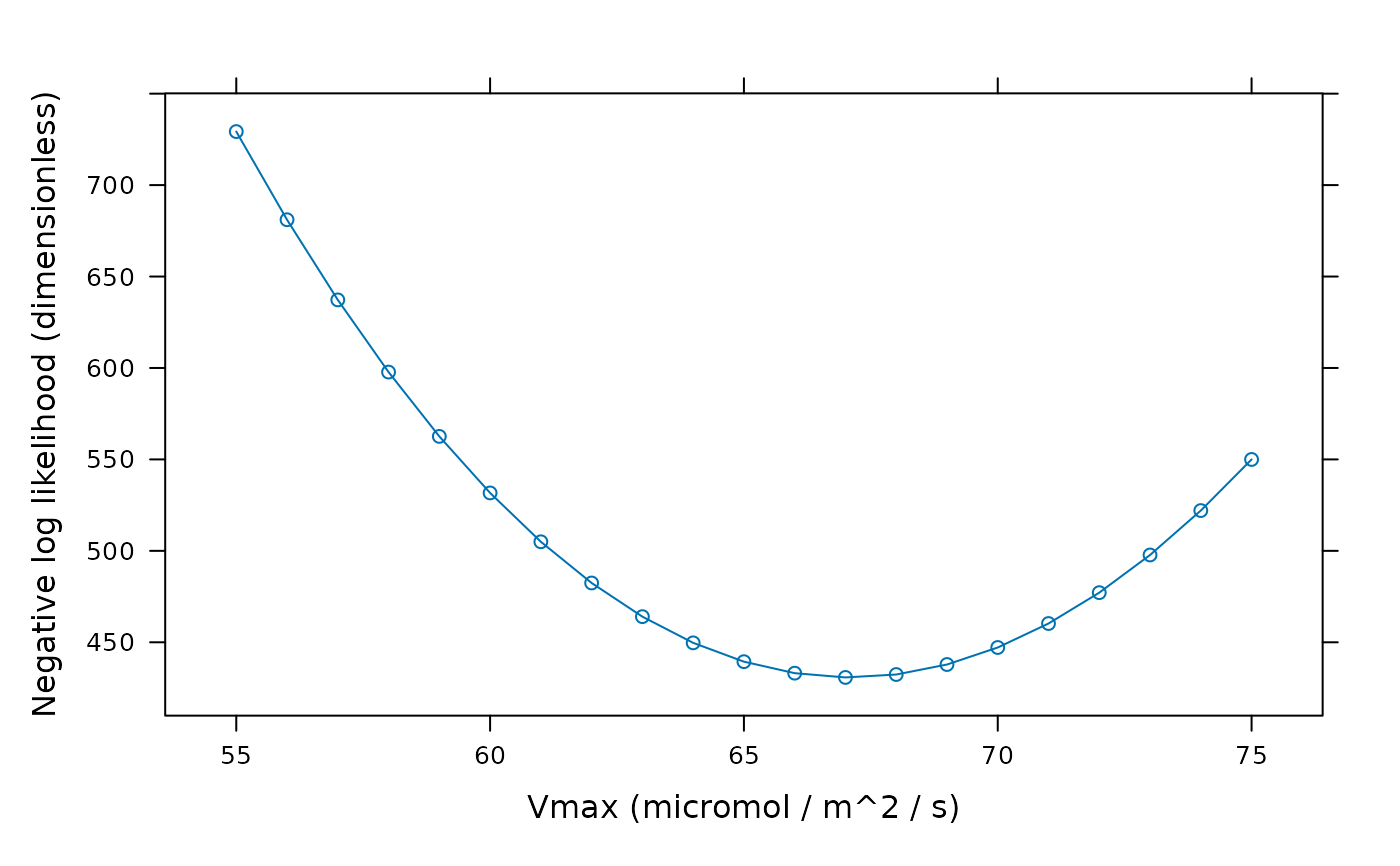Generate an error function for C4 A-Ci curve fitting with a hyperbola
error_function_c4_aci_hyperbola.RdCreates a function that returns an error value (the negative of the natural
logarithm of the likelihood) representing the amount of agreement between
modeled and measured An values. When this function is minimized, the
likelihood is maximized.
Internally, this function uses
link{calculate_c4_assimilation_hyperbola} to calculate assimilation
rate values that are compared to the measured ones.
Usage
error_function_c4_aci_hyperbola(
replicate_exdf,
fit_options = list(),
sd_A = 1,
a_column_name = 'A',
ci_column_name = 'Ci',
hard_constraints = 0,
debug_mode = FALSE
)Arguments
- replicate_exdf
An
exdfobject representing one CO2 response curve.- fit_options
A list of named elements representing fit options to use for each parameter. Values supplied here override the default values (see details below). Each element must be
'fit','column', or a numeric value. A value of'fit'means that the parameter will be fit; a value of'column'means that the value of the parameter will be taken from a column inreplicate_exdfof the same name; and a numeric value means that the parameter will be set to that value. For example,fit_options = list(rL = 0, Vmax = 'fit', c4_curvature = 'column')means thatrLwill be set to 0,Vmaxwill be fit, andc4_curvaturewill be set to the values in thec4_curvaturecolumn ofreplicate_exdf.- sd_A
The standard deviation of the measured values of the net CO2 assimilation rate, expressed in units of
micromol m^(-2) s^(-1). Ifsd_Ais not a number, then there must be a column inexdf_objcalledsd_Awith appropriate units. A numeric value supplied here will overwrite the values in thesd_Acolumn ofexdf_objif it exists.- a_column_name
The name of the column in
replicate_exdfthat contains the net assimilation inmicromol m^(-2) s^(-1).- ci_column_name
The name of the column in
exdf_objthat contains the intercellular CO2 concentration, expressed inmicromol mol^(-1).- hard_constraints
To be passed to
calculate_c4_assimilation_hyperbola; see that function for more details.- debug_mode
A logical (
TRUEorFALSE) variable indicating whether to operate in debug mode. In debug mode, information about theguessis printed each time the error function is called; this can be helpful when troubleshooting issues with an optimizer.
Details
When fitting A-Ci curves, it is necessary to define a function that calculates
the likelihood of a given set of c4_curvature, c4_slope,
rL, and Vmax values by comparing a model prediction to a
measured curve. This function will be passed to an optimization algorithm
which will determine the values that produce the smallest error.
The error_function_c4_aci_hyperbola returns such a function, which is
based on a particular A-Ci curve and a set of fitting options. It is possible
to just fit a subset of the available fitting parameters; by default, all are
fit. This behavior can be changed via the fit_options argument.
For practical reasons, the function actually returns values of -ln(L),
where L is the likelihood. The logarithm of L is simpler to
calculate than L itself, and the minus sign converts the problem from
a maximization to a minimization, which is important because most optimizers
are designed to minimize a value.
A penalty is added to the error value for any parameter combination where
An is not a number, or where
calculate_c4_assimilation_hyperbola produces an error.
Value
A function with one input argument guess, which should be a numeric
vector representing values of the parameters to be fitted (which are specified
by the fit_options input argument.) Each element of guess is the
value of one parameter (arranged in alphabetical order.) For example, with the
default settings, guess should contain values of c4_curvature,
c4_slope, rL, and Vmax (in that order).
Examples
# Read an example Licor file included in the PhotoGEA package
licor_file <- read_gasex_file(
PhotoGEA_example_file_path('c4_aci_1.xlsx')
)
# Define a new column that uniquely identifies each curve
licor_file[, 'species_plot'] <-
paste(licor_file[, 'species'], '-', licor_file[, 'plot'] )
# Organize the data
licor_file <- organize_response_curve_data(
licor_file,
'species_plot',
c(9, 10, 16),
'CO2_r_sp'
)
# Define an error function for one curve from the set
error_fcn <- error_function_c4_aci_hyperbola(
licor_file[licor_file[, 'species_plot'] == 'maize - 5', , TRUE]
)
# Evaluate the error for c4_curvature = 0.8, c4_slope = 0.5, rL = 1.0, Vmax = 65
error_fcn(c(0.8, 0.5, 1.0, 65))
#> [1] 439.4015
# Make a plot of error vs. Vmax when the other parameters are fixed to
# the values above.
vmax_error_fcn <- function(Vmax) {error_fcn(c(0.8, 0.5, 1.0, Vmax))}
vmax_seq <- seq(55, 75)
lattice::xyplot(
sapply(vmax_seq, vmax_error_fcn) ~ vmax_seq,
type = 'b',
xlab = 'Vmax (micromol / m^2 / s)',
ylab = 'Negative log likelihood (dimensionless)'
)
